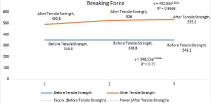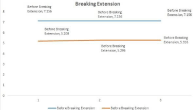
Review Article
Adv Res Text Eng. 2019; 4(2): 1040.
Effect of Yarn Tension on Size Pick up and Strength of Warp Yarn
Lami Amanuel*
Department of Textile Engineering, Wollo University - Kombolcha Institute of Technology, Africa
*Corresponding author: Lami Amanuel, Department of Textile Engineering, Wollo University - Kombolcha Institute of Technology, Ethiopia, Africa
Received: August 20, 2019; Accepted: September 10, 2019; Published: September 17, 2019
Abstract
During sizing; the stretch in the wet & drying zone are totally responsible for loss in elongation which causes more breaks in sizing and the subsequent processes in weaving. If it is not properly controlled in sizing this parameter will considerably result in to reduction of yarn strength which will increase warp breakage rate and machine efficiency in the subsequent processes after sizing. This can be overcome by maintaining no stretch or negative stretch in wet zone between saw box zone & first drying cylinder. If the stretch in the zone does not control properly it will considerably increase the warp breaks at loom, it will ultimately result to reduce loom performance. This study investigated the weaving performance and physical properties of cotton yarn sized at high pressure squeezing. The size penetration, film properties, and the yarn packing density were studied in order to explain the performance of sized yarn. A change in breaking force, elongation at break and abrasion resistance by sizing depends on the sizing conditions, also on the yarn properties before sizing. In addition to the breaking force, which is very important in the weaving process, elongation at break and abrasion resistance etc. largely depend on the fibre and yarn properties, and on the conditions of processing the yarn in sizing. The greatest increase in breaking force by sizing is registered in finer yarns, but also the most level increase considering the samples of the same count. This investigation aims to stress the importance of optimizing size coat to achieve as high production as possible in weaving and product quality. It is emphasized that significance and complexity towards the standardization of sizing in order to produce high-grade yarns were very important.
Keywords: Polymeric carbohydrate consisting; Tensile tester
Introduction
Sizing is the process of applying protective adhesive coating on the yarn surface. This is the most important segment of weaving preparatory process. Increase abrasion resistance and increases the weave-ability of the yarn. Proper sizing practices reduce end breakages at loom, which ultimately increases loom performance.
There are various sizing parameters, which are responsible for maintaining quality of size beam. The machine speed, squeezing roller pressure, viscosity of size paste, temperature of saw box and stretch control are the essential parameters, which need to be control during sizing. A size yarn must have good abrasion resistance, which clearly reflects by its increase tensile strength with minimum loss of elasticity and required amount of moisture for looming. Weavers beam should not have more number of missing ends, cross ends, lappers and taped ends so that it could unwind smoothly in weaving machine. To increase the strength in abrasion resistance of yarn after sizing depend on a number of factor, namely the recipe of the size mixing. Size preparation, level of size pickup and its degree of penetration into the yarn as well as on the sizing condition [1].
During sizing the warp sheet has to be kept under a certain minimum tension for ensuring proper contact of yarn with the drying cylinders, for easy splitting of the warp sheet at the lease rods and for preparing beams of the required density. The effect of stretch on the frequency distribution of elongation of sized yarn and the relationship between the stretch and the loss in yarn elongation during sizing has not been so well documented.
An attempt was made in this study to ascertain the effect of stretch during sizing on the elongation of sized yarn at break and the way in which it affects the performance of the yarn in weaving. An attempt was also made to correlate the stretch in sizing and the loss in yarn elongation during sizing. The other sizing variable which could influence the weave-ability of yarns. E.g. size liquor concentration, its viscosity and temperature, size add-on and machine speed, were kept constant as far as possible. Sized yarn samples were tested for tensile properties on a tensile strength tester.
Materials and Methods
The experiment was conducted on a sizing machine equipped with dry mechanism. The stretch during sizing was measured by using both stretch indicator and mechanical length counters. In each experiment sufficient beams was prepared from the same creel after adjusting the stretch before the start of each beam.
The other sizing variable which could influence the weave-ability of yarns like size liquor concentration ,viscosity and temperature, size add on and machine speed were kept constant as far as possible except the tension. Sized yarns were tested for tensile properties on a strength tester.
The materials used for this investigation were three 100% ring spun cotton yarns with count 34 tex. Size preparation of the yarn, sizing agents and the requirements of sizing process based on two recipes with different concentration were take
Preparation of yarn sample
In the sizing process all the conditions mentioned, which are necessary to achieve maximum sizing results were held constant, due to which it can be safely claimed that yarns were sized under the same conditions. Sizing was carried out using two recipes with a size concentration.
The conditions of sizing process were not varied by changing the recipe or size concentrations. The water temperature in the pre wetting box was 85°C and the size temperature was 90°C. The sizing speed was 40-50 m/min and the temperature on the cylinder of the contact dryer was 4 bar.
To test the sample before and after sizing, methods were used. Thus strength of yarn and elongation at break by single and double yarn tester. Process of this method is; before sizing sample was dried after which they were weighed and then sized, after the samples were dried again and weighed. The amount of size pick up is calculated using
Size pick up = sized yarn – unsized yarn/ unsized yarn*100
Result and Discussion
The following Tables and Figures explain the tensile behavior of sized and Un-sized cotton yarns which are selected for the production of Pillow case.

Figure 1: Single and double Yarn Tensile tester.

Figure 2: Breaking Force of Yarn Strength.

Figure 3: Breaking extension of yarn elongation.
Parameters
Yarn 1
Yarn 2
Yarn 3
Article
Pillow case
Pillow case
Pillow case
Yarn count (Ttn tex)
34 tex
34 tex
34 tex
Yarn twist (twist/m)
780/m
780/m
780/m
Weight (cN*cm)
139.25
139.25
139.25
Table 1: Properties of un-sized yarn.
Sizing agent
Chemical nature
Viscosity
PVA 5kg
Polyvinyl alcohol water soluble synthetic resin
22-27 sec
Starch 50kg
Polymeric carbohydrate consisting glucose
Compound and amount
Concentration %
Recipe
650 lit Water; PVA 5kg; Starch 50kg
7.5 %
Table 2: Characteristics of sizing agent and size recipe.
Temperature of water
85°C
Size temperature in size box
90°C
Dryer temperature
4 bar
Sizing speed
40-50 m/min
Table 3: Sizing condition.
Sizing agent
Chemical nature
Viscosity
PVA 5
Polyvinyl alcohol water soluble synthetic resin
22-27 sec
Starch 50
Polymeric carbohydrate consisting glucose
Compound and Quantity
Concentration %
Recipe
650 lit Water; PVA 5kg; Starch 50kg
7.5 %
Table 4: Characteristics of sizing agent and size recipe.
Machine number
03
Date
17/05/17
Dryer temperature
4 bar
Sizing speed
40-50 m/min
Temperature of water
85°c
Cooking time
25min
Final volume
800
Refractometer
5%
Viscosity
22.80
Number of ends
4828
Table 5: Sizing condition.
Sample A
Sample B
Sample C
Pressure 2.5 bar
Pressure 3 bar
Pressure 3.5 bar
Size pick – up=151.79-139.55/139.55*100=8.76%
Size pick up= 147.21-139.55/139.55 *100=5.48%
Size Pick up= 153.06-139.55/139.55 *100=9.68%
- RPM Unsized: 348.8*34/1000=11.85
- RPM Sized: 490.8*34/1000=16.68
- Strength regain: 16.68-11.85*100/11.85=40.75
- Elongation unsized: 7.15
- Elongation sized: 5.20
- Elongation loss %: 7.15-5.20/7.15*100= 27.27%
- RPM Unsized: 348*34/1000=11.85
- RPM Sized: 526*34/1000=17.8
- Strength regain: 17.10-11.85*100/11.85=44.30
- Elongation unsized: 7.15
- Elongation sized: 5.29
- Elongation loss %: 7.15-5.29/7.15*100= 26.01%
- RPM Unsized: 348.8*34/1000=11.85
- RPM Sized: 535.2*34/1000=18.1
- Strength regain: 17.51-11.85*100/11.85=47.76%
- Elongation unsized: 7.15
- Elongation sized: 5.31
- Elongation loss %: 7.15-5.29/7.15*100= 25.73
Breaking (strength)
Load
cN/tex
Elongation %
Breaking (strength) load
cN/tex
Elongation %
Breaking (strength) load
cN/tex
Elongation %
Before
After
Before
After
Before
After
Before
After
Before
After
Before
After
348.8
490.8
7.156
5.208
348.8
526
7.156
5.296
349.2
535.2
7.156
5.316
Table 6: Test Results of Selected sample spun yarns.
In the sizing process warp tension is a very important and unavoidable parameter. Optimizing the size pick up to achieve the maximum utilization of the sizing process represent the biggest challenge in the whole process. The obtained results indicate that the amount of size pick up and its distribution determination many features of yarn properties. A small difference between the yarns sized with samples of sizing process is easily observable. Significant difference are evident in the yarn sized with sample 1, 2 and 3 in the process, where an almost difference in reduced size pick –up between the standard sizing process and the pre wetting.
From the Figures it was very clear the Sample 3 having optimized strength compared all other samples. The yarn sized with the greater size pick up showed very good result in all important properties in terms of no significant devotion.
Tensile properties of sized and un-sized yarns
The breaking strengths of yarns sized with three different pressure bars are given in Table 6 from which it may be observed the sized yarn breaking strength increases when compared with un-sized yarn, while the breaking extension is reduced. Note that high pressure squeezing produces an increase in breaking strength. This shows that squeezing during sizing causes compactness in the yarn structure, which increases with increasing pressure.
Yarn breaking properties
The most prominent mechanical properties of yarn are primarily breaking properties, which include: breaking force, elongation at break, work to rapture and tenacity. These parameters show us some of the most important yarn characteristics for the weaving process, and the positive impact of sizing to those properties is also one of the most relevant role of the sizing process. Sizing pursued to a greater increase in breaking force and at the same time in a less decrease in elongation at break, which in turn depends on the size pick-up and size distribution in the yarn of un-sized yarn and yarns sized with three different size yarns, where the differences in Force (F) and elongation (e) between the yarns subjected to different processing methods can be clearly seen. The values of breaking force of the tested samples are shown where a very small difference between the sized yarns occurs, with an average increase of almost compared to the unsized yarn. The only yarn that shows a deviation from the others in the form of a small increase in breaking force is the yarn sized sample 3 and the pre-wet sizing process.
Counclusion
The improved weaving performance of yarn sized at high pressure squeezing is due to the better anchorage of the size film arising from increased size penetration and higher packing density. The circularity of the yarn cross sections is not affected by high pressure squeezing, which provides uniform size coating.
Since yarn is split because of various weaving stresses, such as cyclic loading, compression, and abrasion, less splitting means a better weaving performance.
Lower weaving performance may be attributed to the poor adhesive force of size towards cotton fiber and also to the film strength, which provides less protection to the yarn surface.
Size materials, owing to their superior adhesive and cohesive properties, offer better weave-ability. A high degree of penetration inside the yarn provides a better binding force. Poor weave-ability results when there is less penetration of the size material to the yarn core, resulting in a low binding force of fibers.
The adhesive power of a sizing agent is an important factor in the assessment of its suitability as much as the adhesive power of sizing agent is what gives the sized yarn a higher abrasion resistance.
References
- Heap V, Bradford BA. “The Correlation between Abrasion Resistance and Weavability of Sizing Warps”. Melliand Textilberichte. 1988; 69: 12.
- Raichurkar Pramod. Sizing- Impact of process parameter on beam quality and similarly on loom performance. Fibre2fashion.com. 2011.
- Kovacevic Stana, Penava Zeljko. Impact of sizing on physico-mechanical properties of yarn. Fibres and Textiles in Eastern Europe. 2004; 4: 32-36.
- Dolecki SK. “Humidity, Size Content, and Warp Breakage Rates of Spun Yarns”, Text.Manf. 1971; 4: 144.
- Dolecki SK. “Causes of Warp Breaks in the Weaving of Spun Yarns”. J Text Inst. 1974; 65: 68.
- Hari PK, Subramanian TA, Aggarwal SK. “Contribution of Yarn Quality and Sizing to Weavability”. Melliand Textilberichte. 1987; 4: 109.
- Gohl EPG, Vilensky LD. Textile science an explanation of fibre properties, Published by CBS publishers and distributors, Second edition. 1987; 45.
- Aggarwal SK. Balasubramanian – Contribution of some sizing variables to the weavability of yarns, Part II: Contribution of stretch. ATIRA Publication November, 1986.